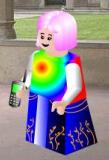 Introduction
IntroductionCarol Richardson sets out the prominence of Bruges as the north European centre for sea trade with the Meditteranean countries. She points out how in Bruges foreign traders, although not allowed to deal directly with each other only through local broker merchants, were integrated into local society and confraternities. This allowed great exposure to Netherlandish art and its resulting influence in Italy.
Chapter 2, Netherlandish networks
Introduction
Kim Woods explains the trade routes that pass through the industrial urban areas of Bruges (North-West Europe) Southern Germany and Northern Italy. How Bruges was the terminus of long distance trade routes both sea routes and overland, and how this exposed Netherlandish work to many foreign merchants and led to the export of both the work and some artists, particularly to Italy. During the 15th Century there was an established market for Netherlandish art outside of the Low Countries with no comparable tendency for non-Italians to commission or purchase Italian Renaissance art.
1. Jan van Eyck and Bruges
This section looks closely at works by Jan van Eyck especially those with foreign connections or patrons such as the Armolfini Portrait 1434 (CB2,P2.2,p67), and on the link with Genoese painters. This section explores the influence of van Eyck on Italian artists particularly his extraordinary naturalistic landscapes, which Italian artists sought to imitate, 'mountains, groves, hamlets, and castles [were] carried out with such skill you would believe one was 50 miles distant from another'. (CB2,p73)
a) Export of ideas.
b) Artists in Bruges seemed to have moved from other places
attracted by Bruges as a vibrant international centre.
c) Netherlandish landscape influenced Italian artists.
d) Single point perspective developed in Italy and travelled north.
2. Bruges after the death of van Eyck
Petrus Christus (died 1475/6)
Petrus Christus arrived in Bruges 1444. He was not an outright imitator of van Eyck but his work 'bears obvious continuity with the Eyckian tradition' (CB2,p73). Portrait of Edward Grimston (CB2,P2.7,p74) was for an Englishman and it is estimated that as much as half of his output was commissioned by Italians or has Italian or Spanish provenance.
Hans Memling (c.1430/40 - 94)
Hans Memling was another immigrant to Bruges coming originally from Selligenstadt near Frankfurt in 1465. It is likely that he had worked with Rogier van der Weyden and like van Eyck and Petrus Christus he continued the reputation for Netherlandish art with the International traders, expatriots and southern European patrons. His Christ as Man of Sorrows (CB2,P.2.13,p80) was either commissioned by an Italian or sent to Italy and was copied by the Florentine artist Domenico Ghirlandaio although in tempera not as in Memlings oils. (CB2,P2.14,p80). Much of his work continues the Eyckian tradition, with detailed landscapes, but, often works appear to have been painted to suit the style and cultural taste of the patron.
Gerard David
Another outsider who became a citizen of Bruges in 1484 and who continued the tradition of quality in Bruges art established by van Eyck, Petrus Christus and Hans Memling. Again much of his work was from international patrons and exported. Particular note is made of the Cervara alterpiece of 1506 which has been adapted in style to suit the Italian taste and culture. (CB2,P2.17,p83)
The strong tradition of painting owed much to incoming painters like those above, reflecting the ability of Bruges' Guilds and Society to accommodate its international status. It also reflects the rigorously enforced quality assurance measures of the Guild.
3. The Export of Netherlandish paintings
Religious paintings for private use
A brief look at two paintings attributed to Robert Campin/Master of Flemele both of which appear to have been exported at some point to Italy, and owned by influential Italian families.
Altarpieces
Several altarpieces are discussed in this section, painted by Netherlandish artists but destined for Italy, Spain, Germany and Scotland. Displaying much typical Netherlandish style, nevertheless, there are in some instances adaptions to accommodate other cultures and specific requests by the donors.
Paintings on Cloth
This section reviews the work of a number of Netherlandish artists who painted on cloth. Rogier van der Weyden, Dieric Bouts, Hugo van der Goes. Cloth was easily transportable, and much of this work appears to have been exported to Italy and produced for sale as opposed to commissions. In the work of Andrea Mantegna (CB2, P2.28 & P2.29, p96) it may be possible to see the influence of the Netherlandish artists.
4. The Netherlands as a training ground for artists
This section deals with the movement of artists to the Low Countries from particularly Spain in order to learn Netherlandish style and also of Low Country artists working in the courts of rulers in other parts of Europe.
Postscript: Quinten Metsys and Antwerp
The postscript focusing on Quinten Metsys describes the move of influence and commerce from Bruges to Antwerp and the evolving influence of the Italian Renaissance from the turn of the 15Th Century. By the mid 1500's it was artists from the North who were visiting Italy to study and learn painting techniques.

No comments:
Post a Comment